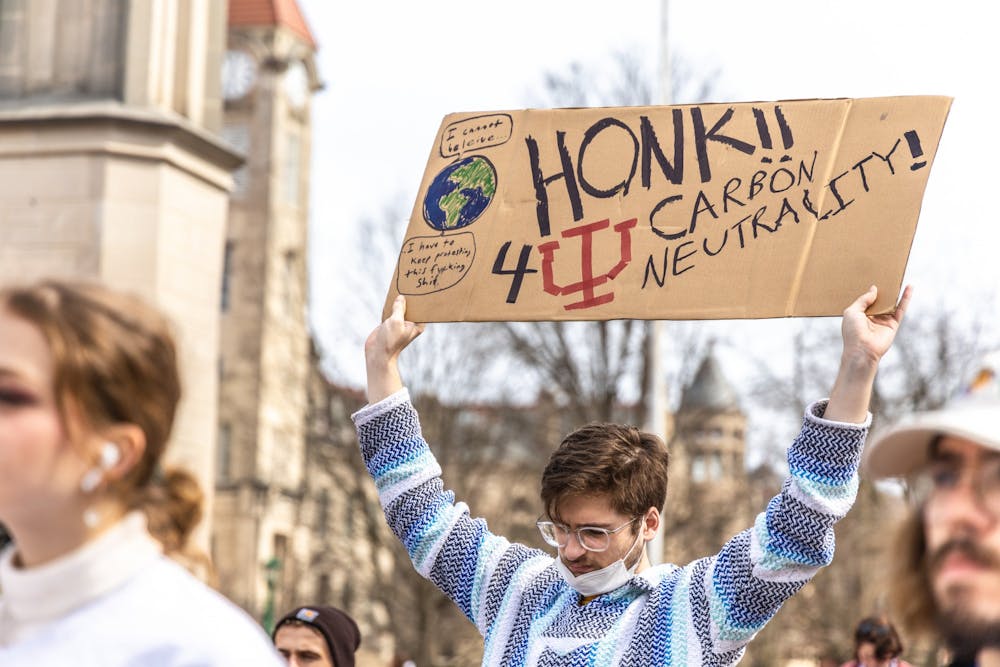IU announced the creation of a Climate Action Planning Committee to identify opportunities to reduce greenhouse gas emissions April 7, but some student leaders and activists said it's not entirely what they advocated for.
The committee serves all IU campuses and is made up of nine faculty members, four staff members and four students from various IU campuses. Many of the faculty members are in the O’Neill School of Public and Environmental Affairs or are experts in earth sciences and geosciences.
Leo Banks, a senior and the IU Student Government director of sustainability, said he was disappointed there were not more students on the committee. Both IUSG and campus activist group Students for a New Green World have also asked that Sustain IU — the university’s sustainability office — be involved in the committee from the start.
“We’re happy that they’ve done it,” Banks said. “But it didn’t really line up with the things we were expecting to see.”
Related: [Undergraduates show solidarity with graduate students through walkout]
Tom Morrison, IU’s vice president for capital planning and facilities, is the chairman of the committee. He said Sustain IU is one of the units that reports to him and that he may look to Sustain IU when staffing the committee. Staffing the committee means asking administrators and staff to conduct work like research and gathering data, he said.
SNGW President Sidd Das said he is concerned about Morrison chairing the committee due to Morrison’s background in facilities and infrastructure.
“Our concern is that Tom Morrison doesn’t have an academic background at all when it comes to sustainability or climate change adaptation and resilience whereas Sustain IU is specifically trained in this,” Das said. “It just doesn’t make any sense to us.”
Morrison said IU President Pamela Whitten selected him as the committee’s chair because areas of the climate action planning involve the university’s infrastructure and operations.
“Much of our progress to date has been in things that are related to operations and infrastructure in the university that kind of fits within my portfolio,” he said.
According to an IU press release, some of the progress includes reduction of electrical consumption and eliminating coal use on IU-Bloomington’s campus. However, a Sustainability Tracking, Assessment, & Rating System report for IUB from February 2020 shows IUB used coal for some electricity and heating some buildings.
IU spokesperson Chuck Carney said the press release meant IU has reduced dependency on coal rather than eliminating it completely. Carney said IU hasn’t used coal for heating purposes in around a decade other than as a backup supply for increased heating demands during the winter.
“Otherwise, we only burn coal for required compliance with regulations and for testing the systems,” Carney said in an email to the Indiana Daily Student.
Das said IUSG and SNGW have been fighting for IU to come up with a climate action plan since spring 2021, when IUSG passed a resolution asking for carbon neutrality by 2040.
Related: [OPINION: Worrying about the graduate worker strike shouldn’t stop undergraduates from taking action]
Morrison said the goal of the committee is to reduce carbon emissions, but said that carbon neutrality is based on some factors outside of IU’s control.
He said he thinks the committee goals will become more defined once they meet.
“I think the charge of the committee will be set by President Whitten, which really hasn’t been done yet,” he said. “I think it’s safe to say we wouldn’t have the committee if our goal wasn’t to reduce carbon.”
He said depending on the subject matter, he may involve student government and the University Faculty Council.
Das said SNGW emailed Whitten asking for a chance to discuss concerns with the committee, and the group still wants a meeting. They’re still protesting, he said. The next rally will be 3:30 p.m. Wednesday in front of Sample Gates.
“We want to show this is a genuine concern of the student body,” he said.




